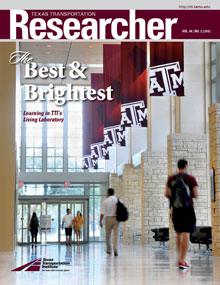A Natural Combination
The partnership between the Texas Transportation Institute (TTI) and the Texas A&M University Zachry Department of Civil Engineering (CE) is a natural — researchers, faculty and students working together to solve real-world problems important to the state and nation.
“Working with TTI is a big part of what we do,” says John Niedzwecki, CE head and Regents professor. “It’s not just transportation — TTI’s projects impact structural engineering, materials engineering, geotechnical engineering, construction and pavements, which are all important areas of study to CE students.”
Teaching
CE, ranked in the top 10 CE programs at public institutions in the nation, prepares students by giving them the fundamentals of civil engineering and a wealth of classroom knowledge. There’s no substitute for hands-on experience, and TTI serves as that bridge between academia and an engineering career, allowing students to work in the field while being mentored by leaders in the transportation industry.
“The undergraduate experience should prepare our students for the workplace upon graduation,” Jon Epps, TTI executive associate director and head of TTI’s Materials, Pavements and Constructed Facilities. “When our students enter careers in transportation, they already have practical knowledge they can put to work immediately.”
TTI relies on graduate students as both employees and innovators who bring different perspectives to their research. TTI employs approximately 100 undergraduate and nearly 100 graduate students who work on research projects sponsored by state and national sponsors.
Working with students in the field, the professors gain valuable knowledge through research and bring it back into the classroom. Students benefit from direct involvement with these projects by learning how things really work.
Research
In the 1950s, early leaders like Gibb Gilchrist and DeWitt C. Greer saw the opportunity to put Texas A&M research to work for the Texas Highway Department. In 1955, Fred Benson became the first director of TTI after serving as a faculty member in CE and dean of the College of Engineering. From that perspective, you could say TTI is a product of CE, and there have always been strong linkages between the two organizations.
“Land-grant universities like Texas A&M have the mission of teaching, research and service,” says Epps. “No other partnership serves this mission better than that between TTI and CE.”
In addition to sharing researchers, TTI and CE also share research facilities. TTI maintains state-of-the-art laboratories, buildings and outdoor test beds. The CE/TTI Building on the main campus of Texas A&M University houses a portion of TTI staff, many of whom are also faculty in the CE department.
“TTI helps Civil Engineering invest in new equipment every year, asking us what we need in order to pursue new research initiatives,” says Niedzwecki. “For example, we needed higher-speed current capabilities in the Haynes Coastal Engineering Laboratory as it was being constructed to be able to take on some new projects, and TTI stepped up to help us purchase the needed equipment.”
“Research is an important part of the undergraduate experience and a necessary part of graduate education,” says Epps. “Students are valuable TTI employees who give as much as they get back.”
Service
The culmination of TTI and CE’s work together is service to Texas, the United States and the world. The partnership puts research into the hands of those who need it — through outreach, workshops, training, and participation in professional and technical associations.
“Service activities are a means of connecting with industry professionals,” says Epps. “One of the greatest rewards of research is the implementation and use of developed research. Service activities provide an opportunity to move research from state of the art to state of the practice.”
Working with the transportation industry ensures that both TTI and CE are delivering the best research and developing the brightest transportation professionals possible
“Looking into the future,” says Niedzwecki, “I can only see this partnership strengthening as we move toward developing and applying new technologies and shared practices, and exploring educational opportunities in the broad field of transportation engineering.”


